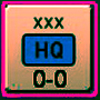ComradeP
Posts: 7192
Joined: 9/17/2009
Status: offline

|
Scenario 3: Grozny and the northern edge of the Caucasus mountain range.
This is the start of turn one, after the 101st Jaeger arrived. I couldn't place it at a frontline town/city, unlike in previous scenarios, so it was unfortunately attached to 1. Panzer Armee, which means I'll have to spend some points on reassigning it.
The plan is to cross the Terek with III and XXXX Panzer Korps, with some infantry support from LII Korps. XXXXIV Korps will hold the western flank. There are also units on the eastern flank, but I expect that they'll mostly try to withdraw across the Terek ASAP as there's nothing to defend on the north bank.
I don't have a lot of fuel, only about 11k, so the blitzkrieg will slow down after 3 or so turns and I might be forced to use only one Panzer Korps per turn after that.
I guess this will be another case of "how many tries did that take?" but in this case the answer is: one. The standard problem of IGOUGO games is that the defender is normally forced to stick to a historical setup on turn 1, whilst the attacker is not necessarily forced to stick to historical objectives or even to the historical setup.
The Speed card can be very effective when forcing crossings, and there are arguments in favour and against whether it should be this effective.
On one hand, getting only a 1 hex bridgehead in two days isn't a lot, especially when considering that the defenders have time to move units around and that something like a checkerboard or carpet defensive setup (like in WitE) can be quite effective due to autoentrenchment making attacks costly (in terms of AP's and not necessarily in terms of casualties) even against units that moved into their positions in the previous turn. Crossing a river into ZOC is also very expensive in terms of AP's and the cost doesn't take into account how many friendly units there are in the hex (so the ZOC "pressure" from the enemy defenders is always the same).
On the other hand, a more extensive breakthrough is problematic for the defenders and more difficult to contain, also considering the historical setup. Still, even a 1 turn bridgehead will just mean the attackers will generally be able to move out on turn 2.
Crossing a river into ZOC costs 85 AP's, which means you can't attack after crossing. However, when you play a Speed card you have 51 AP's left so you can attack the defenders you dislodge from their positions at the river again. After you clear up the ZOC, crossing the river costs 65 AP's, which meants some units could cross and move another hex without a Speed card. 23rd Panzer stayed on the north bank of the river, in case the Soviets would attack the flanks and because I forgot to move some of the units.
The 6 units in the west were attacked by elements of Wiking, 16th Motorized, 3 infantry regiments and elements of two Panzer divisions after being shelled by at least 2 artillery regiments each. The Speed card also allowed some of the Panzerartillerie regiments to fire another, short, salvo to remove a few more entrenchment points.
5 out of the original 8 defending units were destroyed in the follow-up attacks, 1 was badly mauled and panicked and 2 were not attacked twice.
The 389th Rifle Division will probably be encircled.
Soviet casualties were 9700 men or so, mostly from the units that broke, mine were 400.

 Attachment (1) Attachment (1)
< Message edited by ComradeP -- 7/24/2012 2:08:30 PM >
_____________________________
SSG tester
WitE Alpha tester
Panzer Corps Beta tester
Unity of Command scenario designer
|
 Printable Version
Printable Version






























 New Messages
New Messages No New Messages
No New Messages Hot Topic w/ New Messages
Hot Topic w/ New Messages Hot Topic w/o New Messages
Hot Topic w/o New Messages Locked w/ New Messages
Locked w/ New Messages Locked w/o New Messages
Locked w/o New Messages Post New Thread
Post New Thread